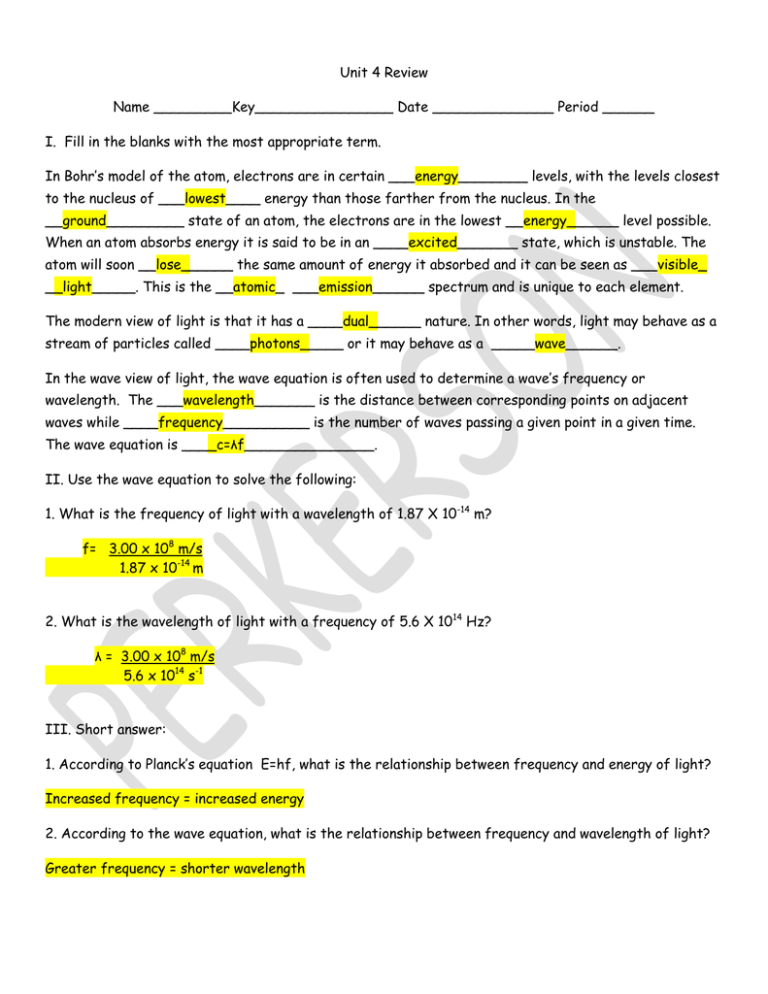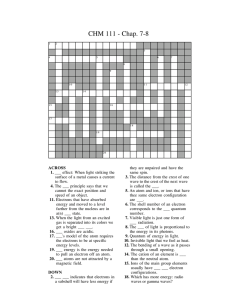Unit 4 Review Name _________Key________________ Date
advertisement

Unit 4 Review Name _________Key________________ Date ______________ Period ______ I. Fill in the blanks with the most appropriate term. In Bohr’s model of the atom, electrons are in certain ___energy________ levels, with the levels closest to the nucleus of ___lowest____ energy than those farther from the nucleus. In the __ground_________ state of an atom, the electrons are in the lowest __energy______ level possible. When an atom absorbs energy it is said to be in an ____excited_______ state, which is unstable. The atom will soon __lose______ the same amount of energy it absorbed and it can be seen as ___visible_ __light_____. This is the __atomic_ ___emission______ spectrum and is unique to each element. The modern view of light is that it has a ____dual______ nature. In other words, light may behave as a stream of particles called ____photons_____ or it may behave as a _____wave______. In the wave view of light, the wave equation is often used to determine a wave’s frequency or wavelength. The ___wavelength_______ is the distance between corresponding points on adjacent waves while ____frequency__________ is the number of waves passing a given point in a given time. The wave equation is ____c=λf_______________. II. Use the wave equation to solve the following: 1. What is the frequency of light with a wavelength of 1.87 X 10-14 m? f= 3.00 x 108 m/s 1.87 x 10-14 m 2. What is the wavelength of light with a frequency of 5.6 X 1014 Hz? λ = 3.00 x 108 m/s 5.6 x 1014 s-1 III. Short answer: 1. According to Planck’s equation E=hf, what is the relationship between frequency and energy of light? Increased frequency = increased energy 2. According to the wave equation, what is the relationship between frequency and wavelength of light? Greater frequency = shorter wavelength IV. Electron distribution: 1. How many energy levels are there? ___7_____ What do they correspond to? _____periods______ 2. There are four types of orbitals: they are ____s,p,d,f____________ __s_ is sphere shaped and there is only one kind - it can hold _2___ electrons total p is dumbbell shaped and there are ___3___ kinds – they can hold a total of ___6__ electrons _d_ is a double dumbbell with a donut and there are __5____ kinds – they can hold _10_ electrons total __f_ is too complex to describe or draw and there are __7_ kinds – they can hold __14_ electrons total Rule that states: Electrons must fill lowest energy levels first ________Aufbau Principle_____________ Each orbital can hold only two electrons ____Pauli Exclusion______________________ Two electrons in the same orbital will have opposite spin ___Hund’s rule_______________ Can’t know the exact location/velocity of an electron __Heinsenberg Uncertainty ______________ Orbitals of equal energy fill singly before doubling ____Hund’s rule______________________ For the following elements, write the complete electron configuration, the noble gas configuration, and the orbital diagram. Si Ni C 1s22s22p63s23p2 1s22s22p63s23p64s23d8 1s22s22p2 Periodic Trends: Atomic radius _____decreases____ across a period and ____increases_______ down a group. Ionization energy ___increases____ across a period and ____decreases______ down a group. Electronegtivity_____increases ___ across a period and _____decreases_____ down a group. Shielding effect_____constant____ across a period and _____increases _____ down a group.


